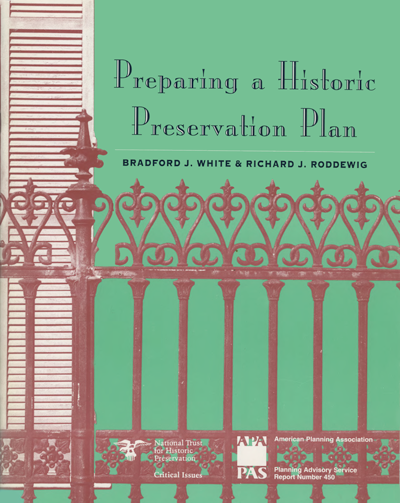Preparing a Historic Preservation Plan
PAS Report 450
By Bradford White, Richard Roddewig

Not a member but want to buy a copy? You'll need to create a free My APA account to purchase.
Create account
The surge in local interest in historic preservation laws has been accompanied by a new wave of planning for the preservation and protection of historic resources.
This report examines the 10 essential elements of a good preservation plan. The authors explain the legal justification for historic preservation and the pitfalls that one can encounter when drafting a plan. Case studies show how various communities have modified these elements to fit individual circumstances and needs.
A look at Atlanta, for example, illustrates how that city was able to build a preservation planning consensus among preservationists and developers.
The appendices include a summary of growth management laws in 11 states that shows how these laws address important historic preservation issues.
Table of Contents
1. Why preservation planning?
Purposes of preservation planning • Types of preservation planning • What is a preservation plan?
2. Elements of a good preservation plan
Statement of goals • Definition of historic character • Summary of past preservation efforts: Preservation context • Historic resources survey • Explanation of the legal basis for historic preservation • Coordinating preservation with zoning, land use, and growth management • Defining public sector responsibilities • Incentives for historic preservation • The relationship between preservation and education • An agenda for future action
3. Preparing and implementing a historic preservation plan
Kane County, Illinois: The evolution of a preservation program • San Francisco: The importance of a survey and evaluation system • Building a preservation planning consensus: Baltimore and Atlanta • Iowa City, Iowa: A comprehensive process • Preservation and zoning: Roanoke, Denver, and Elsah • Lawrence, Kansas: Downtown planning to direct development • Implementing the historic preservation plan • Conclusion
Notes
Appendices
A. Growth management laws, comprehensive planning, and historic preservation planning • B. The Secretary of the Interior's standards for preservation planning, identification, evaluation, and registration • C. Boston Landmarks Commission system for evaluating significance • D. Iowa Cioty, Iowa: Mission and summary of goals • E. Kane County, Illinois: Goals and objectives • F. Providence, Rhode Island: Action strategy for preservation • G. Methodology used to rank buildings in San Francisco's downtown survey


